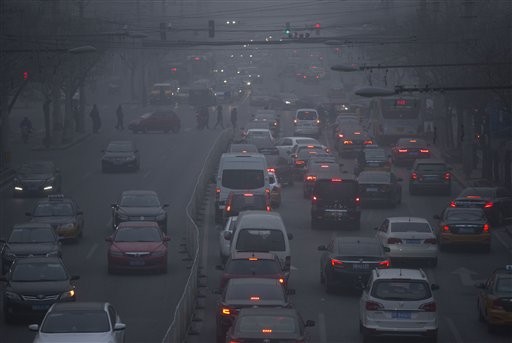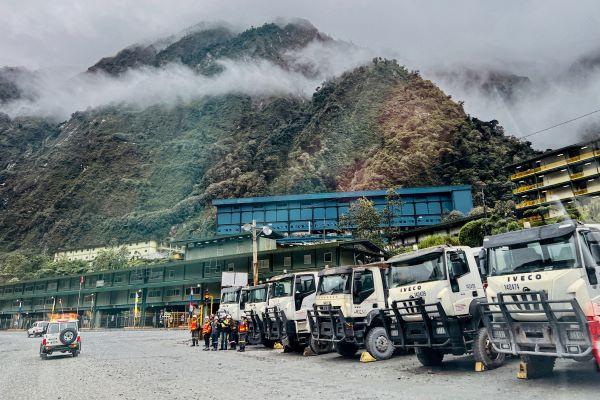A better life with a healthy planet
Whether the record temperatures were directly linked with greenhouse gas emissions, most scientists agree that climate change will make extreme weather more likely.
And climate change is critical to the future being considered right now at the World Cities Summit in Singapore.
It is one of the world’s biggest challenges. On the one hand, ever more people on the planet, and rising standards of living, generating a bigger and bigger demand for energy. On the other, the need to reduce greenhouse gas emissions. And cities are at the heart of the solution.
Change Size
 Pedestrians make their way across a busy intersection on a day with severe air pollution in Beijing, Dec. 25, 2015. (AP/Mark Schiefelbein)
Pedestrians make their way across a busy intersection on a day with severe air pollution in Beijing, Dec. 25, 2015. (AP/Mark Schiefelbein)
C
an you even remember the oppressive heat of the dry season? The heat that, here in Indonesia, sparked a surge in forest fires. The rains washed those flames away, but the heatwave, while it lasted, no doubt caused people to think about climate change.
Whether the record temperatures were directly linked with greenhouse gas emissions, most scientists agree that climate change will make extreme weather more likely.
And climate change is critical to the future being considered right now at the World Cities Summit in Singapore.
It is one of the world’s biggest challenges. On the one hand, ever more people on the planet, and rising standards of living, generating a bigger and bigger demand for energy. On the other, the need to reduce greenhouse gas emissions. And cities are at the heart of the solution.
The global population is growing: from more than 7 billion today, to an estimated 10 billion by the end of the century. And as the number of people swells we expect the growth of cities to accelerate. More than half of the human beings on the planet already live in cities.
By 2050, the proportion is on track to be around three-quarters , with half of this growth in Asia alone.
Today cities consume two-thirds of world energy. By 2040 we can expect cities to be using almost 80 percent.
Demand for energy is rising and rising fast. Even with heroic efficiency efforts, the amount of energy the world is consuming by the end of the century is likely to double compared to today.
Yet how do we halt the accumulation of greenhouse gases like carbon dioxide ( CO2 ) in the atmosphere?
Our team models possible futures and has just published its latest supplement,A Better Life with a Healthy Planet: Pathways to Net Zero Emissions.
In it we can see a possible path — challenging though it may be — to a world where emissions of CO2 are at net zero levels. That means the emissions that remain are offset, or captured and stored below ground. This is something the world must achieve.
Cities, and how we plan them, will be central to achieving this. They have a huge opportunity to become more energy efficient: through building standards; by using waste heat from power generation to warm homes; by encouraging high-density living to reduce travel and encourage smaller electric or hydrogen-powered cars; by building in high-capacity public transport systems.
The evolving energy mix will be vital too. Natural gas, for example, produces half the CO2 and one tenth of the air pollution of coal when burnt for power. Gas power stations also partner well with renewables, providing reliable electricity when there is no sun or wind.
But adding carbon capture and storage (CCS) technology to power stations and industrial complexes will be critical to reduce emissions enough to reach net zero.
Renewables will, of course, continue to grow rapidly as part of the mix, but mainly produce electricity.
Today, electricity accounts for less than one-fifth of the total energy used in the world. For renewables to have a major impact, our scenario shows the share of electricity in the energy mix will need to grow to at least 50 percent.
This means people must meet the costs of, for example, electric or hydrogen-electric cars. Households and businesses not supplied with waste heat must be warmed with electricity. Food processing and light manufacturing must also go electric.
Yet even with all this change, greenhouse gas emissions will continue to enter the atmosphere for the foreseeable future.
The production of chemicals used in so many of the things we take for granted will continue to rely on oil and gas. Where very high temperatures or dense energy storage are required — such as in the manufacture of iron, steel and cement, or in heavy freight and air transport — we will almost certainly see the continued use of hydrocarbon fuels.
There will also be regions that switch to low-carbon energy at different speeds, for political, economic or demographic reasons.
Continuing emissions will have to be offset. We can plant forests and use agricultural practices that raise the carbon content of the soil, such as ploughing partly burned biomass into fields.
We can also burn biomass for power, coupled with CCS. Plants can suck CO2 from the atmosphere. Using CCS can make sure it never goes back.
Whether in cities or beyond, none of this will be easy. But all of it is possible. If the world starts work right now.
***
The writer is vice president for global business environment at Shell and head of the Shell Scenarios team.
---------------
We are looking for information, opinions, and in-depth analysis from experts or scholars in a variety of fields. We choose articles based on facts or opinions about general news, as well as quality analysis and commentary about Indonesia or international events. Send your piece to community@jakpost.com.









